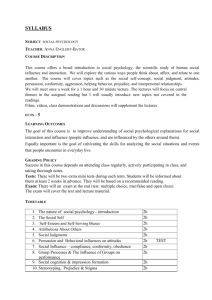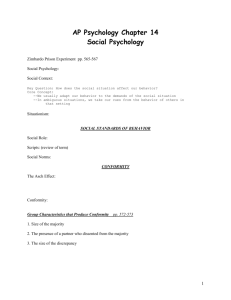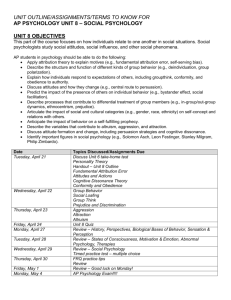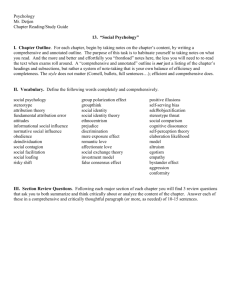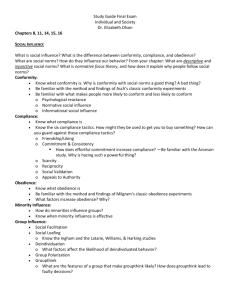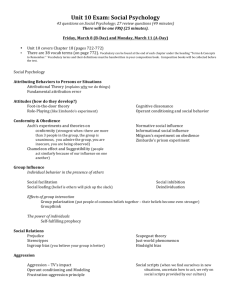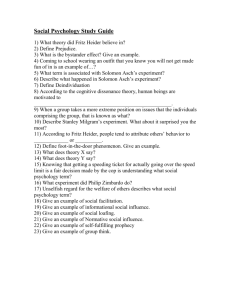Bennett IB Psychology Sociocultural Level of Analysis Review
advertisement
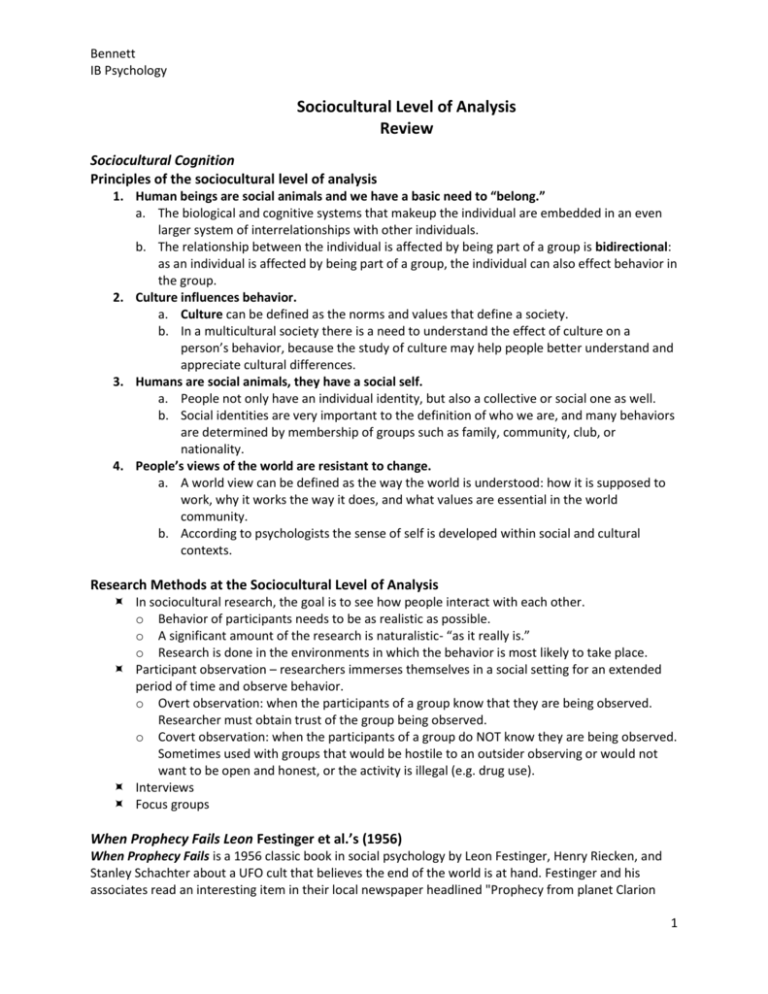
Bennett IB Psychology Sociocultural Level of Analysis Review Sociocultural Cognition Principles of the sociocultural level of analysis 1. Human beings are social animals and we have a basic need to “belong.” a. The biological and cognitive systems that makeup the individual are embedded in an even larger system of interrelationships with other individuals. b. The relationship between the individual is affected by being part of a group is bidirectional: as an individual is affected by being part of a group, the individual can also effect behavior in the group. 2. Culture influences behavior. a. Culture can be defined as the norms and values that define a society. b. In a multicultural society there is a need to understand the effect of culture on a person’s behavior, because the study of culture may help people better understand and appreciate cultural differences. 3. Humans are social animals, they have a social self. a. People not only have an individual identity, but also a collective or social one as well. b. Social identities are very important to the definition of who we are, and many behaviors are determined by membership of groups such as family, community, club, or nationality. 4. People’s views of the world are resistant to change. a. A world view can be defined as the way the world is understood: how it is supposed to work, why it works the way it does, and what values are essential in the world community. b. According to psychologists the sense of self is developed within social and cultural contexts. Research Methods at the Sociocultural Level of Analysis In sociocultural research, the goal is to see how people interact with each other. o Behavior of participants needs to be as realistic as possible. o A significant amount of the research is naturalistic- “as it really is.” o Research is done in the environments in which the behavior is most likely to take place. Participant observation – researchers immerses themselves in a social setting for an extended period of time and observe behavior. o Overt observation: when the participants of a group know that they are being observed. Researcher must obtain trust of the group being observed. o Covert observation: when the participants of a group do NOT know they are being observed. Sometimes used with groups that would be hostile to an outsider observing or would not want to be open and honest, or the activity is illegal (e.g. drug use). Interviews Focus groups When Prophecy Fails Leon Festinger et al.’s (1956) When Prophecy Fails is a 1956 classic book in social psychology by Leon Festinger, Henry Riecken, and Stanley Schachter about a UFO cult that believes the end of the world is at hand. Festinger and his associates read an interesting item in their local newspaper headlined "Prophecy from planet Clarion 1 Bennett IB Psychology call to city: flee that flood." A housewife from Chicago, named Dorothy Martin, had mysteriously been given messages in her house in the form of "automatic writing" from alien beings on the planet Clarion. These messages revealed that the world would end in a great flood before dawn on December 21, 1954. Martin’s cult incorporated ideas from what was to become Scientology. The group of believers, headed by Martin, had taken strong behavioral steps to indicate their degree of commitment to the belief. They had left jobs, college, and spouses, and had given away money and possessions to prepare for their departure on the flying saucer, which was to rescue the group of true believers. Festinger and his colleagues infiltrated Martin’s group and reported the following sequence of events: Prior to December 20. The group shuns publicity. Interviews are given only grudgingly. Access to Martin’s house is only provided to those who can convince the group that they are true believers. The group evolves a belief system—provided by the automatic writing from the planet Clarion—to explain the details of the cataclysm, the reason for its occurrence, and the manner in which the group would be saved from the disaster. December 20. The group expects a visitor from outer space to call upon them at midnight and to escort them to a waiting spacecraft. As instructed, the group goes to great lengths to remove all metallic items from their persons. As midnight approaches, zippers, bra straps, and other objects are discarded. The group waits. 12:05 A.M., December 21. No visitor. Someone in the group notices that another clock in the room shows 11:55. The group agrees that it is not yet midnight. Festinger and his colleagues infiltrated Martin’s group and reported the following sequence of events: 12:10 A.M. The second clock strikes midnight. Still no visitor. The group sits in stunned silence. The cataclysm itself is no more than seven hours away. 4:00 A.M. The group has been sitting in stunned silence. A few attempts at finding explanations have failed. Martin begins to cry. 4:45 A.M. Another message by automatic writing is sent to Martin. It states, in effect, that the God of Earth has decided to spare the planet from destruction. The cataclysm has been called off: "The little group, sitting all night long, had spread so much light that God had saved the world from destruction."Afternoon, December 21. Newspapers are called; interviews are sought. In a reversal of its previous distaste for publicity, the group begins an urgent campaign to spread its message to as broad an audience as possible. Attribution Theory Attribution theory is defined as how people interpret and explain causal relationships in the social world. People may have different ways of attributing causes to events. When people try to understand behavior, they observe other people’s reactions, and make inferences about intention and responsibility. Humans have a need to understand WHY things happen. Examples: o Date/ friend later for dinner – start to think of reasons they are late – car trouble, always late, maybe forget, had prior appointment o Anthropologist – E.E. Evans-Pritchard – Azande people – several people killed when a doorway collapsed. Termites had eaten through door. The people said it was witchcraft – (those particular people were under the doorway because of witchcraft) Actor-observer effect – people tend to make an attribution about a behavior depending whether they are performing it themselves or observing somebody else doing it. Situational factors – something to do with external factors. Dispositional factors – something to do with personal (internal) factors. Examples: o When people discuss their own behavior, they attribute it to situational factors. But when discussing other people it tends to be related to dispositional factors. o Situational – missed the train (late to date) o Dispositional – he/she is so forgetful 2 Bennett IB Psychology Errors in Attribution Fundamental attribution error – when people overestimate the role of dispositional factors in an individuals behavior – and underestimate the situational factors. Self-serving bias (SSB) – people take their successes, attribute them to dispositional factors, and dissociate themselves from their failures, attributing them to situational factors. People gather info from observing others, which leads to illogical conclusions Why this error occurs – we see ourselves as adaptable, flexible, and ever-changing. Meanwhile we “type” people. We think we would act differently under another situation. Placing blame on individual is common practice. Examples: o . Ex actors type casted in roles – Mel Gibson – based on roles seems respectable – but behavior proves shocking. o For murderers people will say he was “evil”. They don’t look at environmental factors. o Football team wins – players and coaches attribute success to internal (good shape, practice, hard work) Greenberg et. al (1982) argue that the reason we do this is to protect our self-esteem. If we can attribute our success to dispositional factors, it boosts our self-esteem, and if we can attribute our failures to factors beyond our control, we can protect our self-esteem. Miller and Ross (1975) argued that cognitive factors play a role in SSB, we usually expect to succeed at a task. o If we expect to succeed and we do, we attribute it to our skill and ability. o If we expect to succeed and fail, we feel that it was bad luck or external factors o If we expect to fail and we don’t so well, we attribute it to dispositional factors. o If we expect to fail and we succeed, we attribute it to external factors and luck. o There is an exception – people who are severely depressed tend to make more dispositional attribution thus blaming themselves for feeling miserable. Kashima and Triandis (1986) found there were significant cultural differences between US and Japanese students. o In the experiment participants were asked to remember details of slides of scenes from unfamiliar countries. o When asked to explain their performance, the Americans tended to attribute their success to ability while the Japanese tended to explain their failures in terms of lack of ability. This is called the modesty bias. Modesty Bias Chandler et al. (1990) also observed this bias in Japanese students, and Watkins and Regmi (1990) found the same in Nepalese students. The role of culture is pivotal in understanding the modesty bias. Bond, Leung, and Wan (1982) found that Chinese students who exhibited the modesty bias instead of the SSB were more popular with their peers. Kashima and Triandis argue that because of the more collective nature of many Asian societies: if people derive their self-esteem not from individual accomplishment but from group identity, they are less likely to use the SSB 3 Bennett IB Psychology Social Identity Theory Henri Tajfel’s social identity theory assumes that individuals strive to improve their self-image by trying to enhance their self-esteem, based on either personal identity or various social identities. Social categorization – theory has been used to explain social phenomena such as ethnocentrism, ingroup favoritism, stereotyping, and conformity to in-group norms. Social identity theory – people can boost their self-esteem through personal achievement or through affiliation with successful groups, and it indicates the importance of social belonging. Social identity theory is based on the cognitive process of social categorization. Social categorization can produce competitive intergroup behavior. o In-group (us) o Out-group (them) Tajfel argues that people who belong to a group – or even are randomly assigned to a group – they automatically think that group as the in-group, and all others as the out group. They will show in-group favoritism, and a pattern of discrimination against the out-group. An individuals self-esteem is maintained by social comparison, meaning the benefits of belonging to the in-group versus the out-group. The outcome of these comparisons is critical because it influences our own self-esteem. Cialdini et al. (1976) demonstrated this phenomenon among college football supporters. After a successful football match, the supporters were more likely to be seen wearing college insignia and clothing than after defeats. Tajfel (1978) – the establishment of positive distinctiveness - It is assumed that our need for positive self-concept will result in a bias in these intergroup comparisons, so that you are more positive towards anything that your own group represents. Tajfel et al. (1971) the Kandinsky versus Klee experiment - Boys, 14-15 years old, were shown 12 slides portraying different painting. One half of the paintings were by Kandinsky and the other half were painted by Klee. Boys were asked to express their preferences, which paintings did they like and which paintings did they hate. Tajfel found that when people are assigned to a group casually (flip of coin, hat draw) – they see themselves as being similar in attitude and behavior, and a bond is formed, even if they did not know each other before. All the boys viewed the paintings without the signatures of the painter. Keep in mind that the boys were not aware of the painters of the pieces that they said were good or not. The boys were seemingly allocated to two separate groups. They were given the impression that this grouping was based on the impressions that the experimenters received from them after the initial part of the experiment. The two groups were named Kandinsky group and Klee group. The names that were given to the group added up to the impression that the groupings were based on the expressed preferences of the boys but the truth is, the grouping was completely randomized. The last stage of the experiment is the rewards allocation task. Each boy was given a task to award points to two other boys, one from his same group and one from the other group. The only information that each boy was given were code numbers and the name of the group of the two boys they were supposed to award. There were two systems of awarding points that were employed by the researchers. In the first system of point awarding, the boys generally awarded more points to the members of their in-group showing ingroup favoritism. In the second system of point awarding, the boys generally opted to maximize the 4 Bennett IB Psychology difference between the profits of the two groups favoring their in-group. One of the most obvious conclusions that we can draw from this experiment is the natural tendency of members of a group to favor their in-group. Despite the seemingly meaningless groupings created by the experimenters, the subjects were able to identify with their respective groups and create a positive social identity through giving their in-group more points. This phenomenon can be likened to “self-serving bias.” Since every individual within a group was able to identify themselves with their group, the group is now associated with one’s self, thus, benefit of the group identified with the self is prioritized. Limits of social identity theory Social Identity Theory is a good way of understanding human behavior. It describes but does not accurately predict human behavior. Using the theory on isolation is reductionist, meaning it fails to address the environment that interacts with the “self”. The environment includes cultural expectations, rewards as motivators, and societal constraints such as poverty may play more of a role in behavior than one’s sense of in-group identity. Serge Moscovici Romanian-born French social psychologist. Born into Jewish family and suffered the effects of antisemantic discrimination: in 1938 he was expelled from a Bucharest high school. Research focus is on group psychology and his theory of social representations is now widely used. Criticizes US research on conformity to the majority and instead did research that showed the opinions of a minority may influence those of a larger group. Social Representations Social Representations – the shared beliefs and expectations held by society in which we live or the group to which we belong. According to Moscovici (1973) Social representations are the foundation of social cognition – they help us to make sense of our world, enables communication between the community. Social representations are basically cultural schemas that are fundamental to the identity of the group, and they provide a common understanding foe communication within the group – EXAMPLE: a group may have its own social representation of success, beauty or intelligence. Alfred Adler (1990) did a study where he found that if you ask a Russian mother to describe what it means for her child to share something, she will describe her children playing together with a toy at the same time. An American mother will describe her children taking turns to play with the same toy. Caroline Howarth (2002) carried out focus- group interviews with adolescents living in Brixton in London. She wanted to see how social representations of Brixton affected the identity of adolescents girls. Her focus groups used groups of friends, so that controversial, and sometimes personally upsetting, topics could be discussed with empathy and respect. She found that the very negative representation of “being from Brixton” by those from outside the area was not shared by people living there. People from Brixton found that the people who lived there were “a diverse, creative, and vibrant” community. Representations may become the basis for stereotyping – both negative and positive – and how this can contribute to social identity. This representation is an influence on the identity of those in 5 Bennett IB Psychology Brixton – it influenced how the girls made friends and joined sports teams, their relations with the police, and their employment opportunities. Stereotyping Stereotype – a social perception of an individual in terms of group membership or physical attributes. Stereotyping is a generalization that is made to a group and then attributed members of a group. Generalization may be positive or negative. Stereotyping is a form of social categorization that affects the behavior of this who hold the stereotype, and this are labeled by a stereotype. Researchers now explain stereotyping as a result of schema processing. Stereotype threat - the experience of anxiety or concern in a situation where a person has the potential to confirm a negative stereotype about their social group. First developed by social psychologist Claude Steele and Joshua Aronson (1995), stereotype threat has been shown to reduce the performance of individuals who belong to negatively stereotyped groups. According to Steele (1997) Stereotype threat turns on spotlight anxiety, which causes emotional distress and pressure that may undermine the performance. Spencer et al. (1977) – tested women’s mathematic abilities. Researcher’s gave difficult math tests to students who were strong in the area. They predicted that women would underperform, “stereotype threat.” Result: Women significantly underperformed compared with equally qualified men. When both groups took literature test, both performed equally well, there was no “stereotype threat.” The formation of stereotypes Tajfel argues that the formation of stereotypes is a natural cognitive process of social categorization, but that does not explain how it actually happens. Campbell (1967) maintains that there are two key sources of stereotypes: o Personal experience with individuals and groups o Gatekeepers – media, parents, and other members of our culture Campbell claims that stereotypes have a basis in some reality. His grain of truth hypothesis argues that and experience from an individual from a group will then be generalized to the group. Hamilton and Gifford (1976) argue, instead that stereotypes are the result of an illusionary correlation – meaning, people see a relationship between two variables even when there is none. Example: when people form false associations between membership of a social group and specific behaviors, such as a woman’s inferior ability in math. The illusory correlation phenomenon causes people to overestimate a link between the two variables, here “women” and the “ability in math”. Once illusory correlations are made, people tend to seek out or remember information that supports this relationship. Illusory correlations can come in many forms of culturally based prejudice about social groups can to some extent be classified as illusory correlations. This is an example of confirmation bias. Confirmation bias makes stereotypical thinking resistant to change. Illusory correlation is what researchers call “cognitive bias” – a person tendency to make errors in judgment based on cognitive factors. Attribution errors are also example of cognitive bias. Snyder and Swann (1978) conducted a study in which they told female college students that they would meet a person who was either introverted (reserved, cool) or extroverted (outgoing, warm). They were then asked to prepare a set of questions that confirmed their perceptions about introverts and extroverts. Those who thought they are going to meet an introvert asked, “ What do you dislike about 6 Bennett IB Psychology parties?” or “Are their times you wish you could be more outgoing?” and extroverts were asked, “What do you do to liven up a party?” The researchers concluded that the questions asked confirmed the participants stereotype of each personality type. Stereotypes can also be formed as a means of taking on the in-group’s social representation of the outgroup. Individuals may conform to the group norms with regard to the “other”. Rogers and Frantz (1962) found that white immigrants to Rhodesia (now Zimbabwe) developed more stereotypes – and prejudice – against the people the longer they stayed there. They argue this is because they adopted the social representations that were dominant in the group they were joining. Research on stereotyping , prejudice, and discrimination is difficult to carry out. Social desirability effect is a confounding variable in such research. Although some research stereotyping and prejudice indicates a decrease in the frequency of such behaviors. It is difficult to know if this is truly the case, or whether it is simply “politically incorrect” to make such statements. This has meant that in today’s research on stereotyping and prejudice, researchers are moving away from self-report methods and looking at other ways to study this behavior. Confirmation bias, generally means that people tend to overlook information that contradicts what they already believe. In a social context, they pay attention to behaviors that confirm what they believe about a group and ignore those behaviors contrary to their beliefs. Social and Cultural Norms Norm – set of rules based on socially or culturally shared beliefs of how an individual ought to behave. Norms regulate behavior within a group, when individuals deviate from social or cultural norms, they may be punished, marginalized, stigmatized, or – more positively – seen as creative and affecting change in the society. Being social animals the need to belong plays a strong role in the desire to conform to group norms. Social Learning Theory Albert Bandura social learning theory assumes that humans learn behavior through observational learning. Observational learning – people can learn by watching models and imitating their behavior. Sometimes the model is trying to have a direct effect on the learner – for example, when a teacher instructs students how to solve a problem. Often models serve as indirect models, in that they are not trying to influence behavior. According to Bandura, social learning theory involves the following factors: o Attention – the person must first pay attention to the model. o Retention – the observer must be able to remember the behavior that has been observed. o Motor reproduction – the observer has to be able to replicate the action. o Motivation – learners must want to demonstrate what they have learned. 7 Bennett IB Psychology There are several factors which may influence whether or not the observer decides to imitate and learn: o Consistency – if the model behaves in a way that is consistent across situations then the observer will be more likely to imitate than if the model behaves in different ways depending on the situation. o Identification with the model – there is a tendency to imitate models who are like ourselves. o Rewards/punishment –Bandura argues that people can learn from observing what happens to others; they don’t have to experience the consequences themselves. This is called vicarious reinforcement in Bandura’s theory and happens when we watch people around us – whether in reality or in movies (observational learning). o Liking the model – warm and friendly models are more likely to be imitated than cold, uncaring models. o A study by Yarrow et al. (1970) showed that children learn altruistic behavior (helping others for no personal gain) better from people with whom they have already developed a friendly relationship than from people they do not know. Albert Bandura (1925 – present) joined department of psychology at Stanford University in 1953 and stayed there until he retired. His famous experiment involved the use of a Bobo doll and aggression in children. Social learning theory changed the direction of psychology and continues to be very influential in all areas of psychology. Application of social learning theory in real life Social Learning theory has been used to explain many things but particularly the role of violence in the media on aggression in children. Studies shows that by watching aggression (violence on TV), children learn how to be aggressive in new ways and they also draw conclusions about whether being aggressive to others will bring them rewards or punishment. Huesmann and Eron (1986) longitudinal study, monitored children’s behavior over 15-year period. They found a positive correlation between the number of hours of violence watched on TV by elementary school children and the level of aggression demonstrated when they were teenagers. They also found that those who watched a lot of TV violence when they were 8 years old were more likely to be arrested and prosecuted for criminal acts as adults. Kimball and Zabrack (1986) carried out in Canada, children were found to have become significantly more aggressive two years after TV was introduced to their town. TV is not always a negative influence. There is a strong evidence that children's shows (Sesame Street) can help children learn positive behaviors such as empathy, sharing, and academic curiosity. Bandura’s social learning theory is the basis for several TV and radio dramas which aim to prevent unwanted pregnancies, reduce the spread of HIV, promote literacy, and empower women in developing countries. This is called the Sabido method. The sabido method designs and produce radio and TV dramas that aim to change people’s behaviors. Broadcasting of soap opera Twende na Wakati (Let’s Go with the Times) in Tanzania between 1993 and 1996, researchers found increases in safe sex, women’s status and family planning. 8 Bennett IB Psychology Evaluation of social learning theory Social learning theory helps explain why behaviors may be passed down in a family or within a culture. Also explains how children can acquire some behaviors without trial-and-error learning. Criticism: Children that see a behavior demonstrated, may not exhibit that behavior for sometime. Because of this gap, it is difficult to establish 100% that the behavior is the result of observing the model. The model doesn’t explain why some people never learn a behavior, in spite of seeing the model. People are motivated by role models and their own beliefs and previous experience. Social influence: compliance Compliance – the result of direct pressure to respond to a request. Compliance is another important aspect of behavior within a group. Conformity occurs when the situation does not exert direct pressure to follow the majority, but the pressure is often perceived by individuals as influencing their behavior. Compliance techniques are used for advertising and marketing, where sales tactics are examined in the basis of what would most likely to persuade consumers to buy specific products. Example: when people comply to buy certain products, even though the direct pressure may not always be apparent to the individual. Robert Cialdini outlined compliance techniques (ways in which individuals are influenced to comply with the demands or desires of others.): o Authority: people comply more often with those in positions of some authority. Example: Famous people are used to brand a product so people associate brand w/ the celebrity o Commitment: once people have agreed to so something, either by their behavior or by a statement of belief, they are more likely to comply with similar requests. o Liking: people comply with requests from people they like. o Reciprocity: people often feel they need to “return a favor” o Scarcity: opportunities seen more valuable to people when they are less readily available. This is why there are so many “last chance” and “limited time only” sales. o Social proof: people view a behavior as correct if they see others performing it. Reciprocity Reciprocity principle – the social norm that we should treat others the way they treat us. Arousal of feelings of guilt plays a key role in reciprocity. Many cultures offer gifts, free travel, or free time in hotels to potential customers, this makes the person feel guilty into purchasing their product. Lynn and McCall (1998) found that when restaurant customers are given a mint or sweet with their bill, the size of the tip they leave increases. Reciprocity does not always involve giving gifts. It can also be because the other person has already compromised on what he or she wanted, and that this compromise should be acknowledged with some behavior. Door-in-the-face-technique – a request is made which will surely be turned down. Then a second request is made which asks less of someone. People are more likely to accept the second request because they feel the person has already lowered the request in order to accommodate them. 9 Bennett IB Psychology Door-in-the-face technique study by Cialdidni et. Al (1975): Cialdini asked students to volunteer to counsel juvenile delinquents for two hours a week for two years. After their refusal, they were asked to chaperone juvenile delinquents on a one-day trip to the zoo. 50% agreed to chaperone the trip to the zoo as compared to 17% of participants who only received the zoo request. Additionally, Cialdini created a control group where the experimenter described both the extreme and the smaller favor, and then the participant was requested to perform either one. Only 25% of the students agreed to the zoo request. This demonstrates that exposure to the more extreme task is irrelevant and does not greatly affect compliance. Door-in-the-face technique will only affect compliance rates if the extreme request is rejected first. Commitment Cialdini argues that once people make a choice or take a stand, they will encounter personal and interpersonal pressures to behave consistently with that commitment. Kurt Lewin (1951) argued that behavior is motivated by goal gradients. The longer people commit themselves to something, the less likely they are to abandon the goal. Foot-in-the-door technique – getting people to make a commitment to something small, with the hope of persuading them to agree to something larger. Dickerson et. Al (1992) – had students sign a poster committing to take shorter showers, and they gave them a survey that made them think about their water usage. Students who signed the poster and completed the survey had average shower times of about 3.5 minutes. Much lower than other university students in the same dorms. Cialdini (1974) demonstrated the low-balling technique by asking students to participate in an experiment. 56% agreed, before being told that the experiment started at 7:00 AM. They then told the volunteers that the study was scheduled at 7:00 AM, and the volunteers could withdraw if they wished. None did so, and 95% turned up at the scheduled time (the Low-Ball group). When a control group was asked to participate and were told the unsocial timing of the experiment up front, only 24% agreed to participate. o The low-ball is a persuasion and selling technique in which an item or service is offered at a lower price than is actually intended to be charged, after which the price is raised to increase profits. o If a person is already enjoying the prospect of an excellent deal and the future benefits of the item or idea then backing out would create cognitive dissonance, which is prevented by playing down the negative effect of the "extra" costs. Hazing- a series of initiation rites in order to join an exclusive group, such as a sports team, or university fraternity. o The individual must first choose to join the group, recognizing that there will be some imitation rite which her or she will have to endure. o During the hazing, the participant must rationalize that this is “worth it” in order to be part of the group. o Having completed the hazing, the individual has a sense of accomplishment, having proven his/her loyalty. o Aronson and Mills (1959) investigated dissonance using an effort justification paradigm. Female participants, who were joining a discussion group about the psychology of sex, were either accepted into the group (control condition), had to go through a mild initiation, which involved 10 Bennett IB Psychology reading aloud sex-related words, or had to go through a severe initiation by reading aloud explicit sec words (Aronson 1959). When the participants were later asked the rate the discussion and the group members, those who went through severe initiation rated both categories much higher than both the control and mild initiation groups. Because the female participants had to justify the effort and humiliation they experienced to enter the group, they rated the group as more attractive than the other conditions. o Gerard and Mathewson (1966) women received electric shocks. Those who endured pain as part of their initiation were more likely to find their group interesting, intelligent, and desirable. Social influence: Conformity Conformity – an indirect social influence, people tend to adjust their thoughts, feelings, or behavior that are in agreement with those of a individual or particular group, or with accepted standards about how a person should behave in specific situations (special norms). The term “peer pressure” is used to describe the conformity seen in schools, but conformity occurs at all levels of society and it is not always simply about the need to sit in with a group of friends at school. Solomon Asch (1951) - Asch Paradigm The participants — the real subjects and the confederates (part of the study, unknown to real subjects) — were all seated in a classroom. They were asked a variety of questions about the lines such as how long is A, compare the length of A to an everyday object, which line was longer than the other, which lines were the same length, etc. The group was told to announce their answers to each question out loud. The confederates always provided their answers before the study participant, and always gave the same answer as each other. They answered a few questions correctly but eventually began providing incorrect responses. In a control group, with no pressure to conform to an erroneous view, only 1 subject out of 35 ever gave an incorrect answer. Asch hypothesized that the majority of people would not conform to something obviously wrong. When surrounded by individuals all voicing an incorrect answer, participants provided incorrect responses on a high proportion of the questions, 32% agreed with incorrect responses in half or more of the trials. 24% of the participants did not conform to any of the incorrect responses given by confederates. 75% of the participants agreed with the confederates and gave an incorrect answer to at least one question. As long as the dissenting confederate gives an answer that is different from the majority, participants are more likely to give the correct answer.One difference between the Asch conformity experiments and the Milgram experiment is that the subjects of these studies attributed their performance to their own misjudgment and "poor eyesight", while those in the Milgram experiment blamed the experimenter in explaining their behavior. 11 Bennett IB Psychology The Asch paradigm has been replicated many times. Out of those variations and replications, psychologists have found that the following factors influence the likelihood to conform to the group. o Group size: Asch (1955) found that with only one confederate, just 3% of the participants conformed; with two confederates, it rose to 32%. Larger groups did not increase the rate of conformity. In some cases, very large groups even decreased the level of conformity. o Unanimity: Conformity was most likely when all the confederated agreed (Asch 1956). If one of the confederates disagreed, even if it was also an incorrect answer, the participant was significantly less likely to conform. o Confidence: When individuals feel that they are more competent to make decisions with regard to a field of expertise, they are less likely to conform. o Perrin and Spencer (1988) found that when they replicated Asch’s study with engineers and medical students, conformity rates were almost nil. o Self-esteem: Stang (1973) found that participants with high self-esteem were less likely to conform to incorrect responses. Criticism of Asch Paradigm: o Artificiality and ecological validity – do these experiments accurately predict real-life situations? o Culture: in the original study only one culture was studied. Culture changes, the study may not even be valid today. o Ethics: participants deceived, made to feel anxiety about their performance. o Friend et al. (1990): argue there is a bias in interpretation of findings. Claims it should be striking to us that in the face of unanimity so many people did not conform. We should study the factors that allow people to dissent, rather than conform. A different way of looking at the Asch paradigm Moscovici argues that when a minority maintains a consistent view, it is able to influence the majority. Moscovici and Lage (1976), four participants and two confederates described a blue-green color as green. They found that the minority was able to influence about 32% of the participants to make at least one incorrect judgment about the color of slides they were shown. Also the participants continued to give their incorrect responses even after the confederates had left the experiment. Hogg and Vaughan (1995) argue that some of the reason for the influence of a minority group could be as follows: ◦ Dissenting opinions produce uncertainty and doubt. ◦ Such opinions show that alternatives exist. ◦ Consistency shows that there is a commitment to the alternative view. Why do people conform? Deutsch and Gerard (1955) argue that conformity is a result of informational social influence and normative social influence. ◦ Informational social influence is based on the way people cognitively process information about a situation. Festinger (1954) said that people evaluate their own opinions and ideas through social comparison, meaning looking at what others do. When one notices that others are not behaving in the same way , or that they think differently, it causes anxiety. Festinger called this cognitive dissonance. 12 Bennett IB Psychology Normative social influence is based on our nature as social animals. People have a need to be accepted by others and to belong. Cultural aspects of conformity Studies show Asian cultures engage in more conforming behaviors that Americans do, and they also value it to a greater degree. Americans see conformity as a negative trait. Cashmore and Goodnow (1986) found that there was a high level of conformity among Italians. Burgos and Dias-Perez (1986) found that with regard to childrearing, Puerto Ricans valued conformity and obedience in their children. Bond and Smith (1996) study found that individuals from collectivistic cultures (Africa, Asia, South America) tend to conform more than their counterparts from individualistic cultures do (North America and north-west Europe). Berry (1967) found higher rates of conformity among the Temne of Sierra Leone, a high foodaccumulating society with strict disciplinarian socialization practices, compared with the Eskimo of Baflin Island, a low food-accumulating society whose socialization practices are lenient and encourage individualism. Cultural norms There are many definitions of culture, and it is a very complex concept. o The term “surface culture” is used to describe visible aspects like food, eating habits, clothing, rituals, communication patterns, religion, and behavior). o The term “deep culture” is related to beliefs, attitudes and values that underpin culture manifestations. o Kuschel (2004) claims that culture should not be used to explain behavior. It should be used to understand how people have survived in their environment, how they organized their life, and how their beliefs influence behavior. o Lonner (1995) describes cultures as common rules that regulate interactions and behavior in a group as well as a number of shared values and attitudes in the group. o Hofstede (2002) described culture as “mental software,” meaning cultural schemas that have internalized so that they influence thinking, emotions, and behavior. o Matsumoto (2004) describes culture as “dynamic system of rules, explicit and implicit, established by groups in order to ensure their survival, involving attitudes, values, beliefs, norms, and behaviors.” o Culture is dynamic because it changes over time due to environment and social changes. o cultural norms – behavior patterns that are typical of specific groups. They are often passed down from generation to generation by observational learning by the groups gatekeepers – parents, teachers, religious leaders, and peers. o Cultural norms include how people choose marriage partners, attitudes toward alcohol consumption, and acceptance (or rejection) of spanking children. The etic approach to psychology compares human behavior across specific cultures. Etic study involves drawing on notion of universal properties of cultures, which share common perceptual, cognitive, and emotional structures. The emic approach looks at behaviors that are culturally specific. Emics have challenged psychologists to re-examine their ideas 13 Bennett IB Psychology Cultural dimensions of behavior dimensions- the perspectives of a culture based on values and cultural norms. Hoefstede (1973) study involved asking employees of the multinational company IBM to fill in surveys about morale in the workplace. He then carried out content analysis on the responses he received, focusing on key differences submitted by employees in different countries. His research looked at the 40 most represented countries in the surveys. The trends he noticed he called “dimensions.” Hoefstede argues that understanding cultural dimensions will help facilitate communication between cultures. This is important in international diplomacy as well as international business. International business – in the US, shaking hands seals the deal. In middle eastern countries shaking hands means that serious negotiations have just begun. Causes problems when doing business with people from a different culture. Types of dimensions: o Individualism: in individualist societies the ties between individuals are loose. Everyone is expected to look after himself or herself and his or her immediate family. o Collectivism: in collectivist societies from birth onwards people are integrated into strong, cohesive in-groups, often extended families( with uncles, aunts, and grandparents), which provides them with support and perfection. Not living up to norms, very severe punishment. o Uncertainty vs. avoidance- deals with the societies tolerance for uncertainty and ambiguity. It indicate to what extent a culture programs its members to feel either uncomfortable or comfortable in unstructured situations: unstructured situations are novel, unknown, surprising. Bond (1988) argues that Chinese culture replaces the uncertainty-avoidance dimension with Confucian work dynamism: instead of focusing on truth, some countries focus on virtue. o China and other countries have a long-term orientation. These cultures value persistence, loyalty, and trustworthiness. They need to protect the collective identity and respect tradition – what is called “saving face.” Hoefstede found that Finland, Germany, and the US have a short-term orientation. In contrast to the Confucian work dynamism, these cultures value personal steadiness and stability. There is a focus on the future instead of the past, and innovation is highly valued. Hoefstede warns against the ecological fallacy, meaning when one looks at two different cultures, it should NOT be assumed that two members from two different cultures must be different from one another, or that a single member of a culture will always demonstrate the dimensions which are the norm of that culture. Anthropologist, Edward T. Hall’s norms that define culture. o proxemic theory (1966) is based on a culture's need for “personal space.” Different cultures have different perceptions of the amount of personal space that is required to be comfortable. People only allow their closest, most intimate friends into this bubble of space. o US – people in conversation will assume distance of 4-7 inches, but in many parts of Europe the expected social distance is roughly half that. o Americans overseas experience urgent need to back away from a conversation partner when they get too close. o Time consciousness – there is a distinction between monochronic cultures and polychronic cultures. o Monochronic – focus on one thing at a time, high amount of scheduling, and punctuality, meeting deadline highly valued. 14 Bennett IB Psychology o Polychronic – many things happen at once, more focus on relationships and interactions. Interruptions are expected as a part of life, little frustration when things are postponed or late. An integrative approach to prejudice and discrimination Stereotyping is a cognitive process whereby people categorize others for example, in terms of belonging to a social group or simply just on the basis of their looks – think about the many jokes about blondes. Once a set of characteristics are used to describe a group of people, those characteristics are often attributed to all members of the group. Prejudice is an attitude. An attitude can be defined by as the combination of emotion and cognition. Not only does a person judge an individual based on a set of characteristics that is attributed to him or her because of the group to which he or she belongs, but contact elicits and emotional response. Prejudices may or may not be based on stereotyping. Discrimination is a behavior. Discrimination is when a person treats someone differently based on his or her membership of a group, rather than on individual merit. This type of behavior can range from denying the person a job (e.g. because they are overweight, old, or suffer from a physical disability) to segregation, to violent hate crimes. Biological research on the origins of prejudice The Implicit Association Test (IAT) is designed to detect the strength of a person's automatic association between mental representations of objects (concepts) in memory. o A computer-based measure, The IAT requires that users rapidly categorize two target concepts with an attribute (e.g. the concepts "male" and "female" with the attribute "logical"), such that easier pairings (faster responses) are interpreted as more strongly associated in memory than more difficult pairings (slower responses). o The results of an IAT test are thought to measure an individual's implicit attitudes: actions or judgments occur without the performer's awareness. o Banaji and Greenwald (1998) were the developers of the IAT Susan Fiske (2007) participants were placed into an MRI scanner and then shown a series of photos. These photos included people with disabilities, rich businessmen, older people. US Olympic athletes, and homeless people. Fiske was surprised that when participants viewed the photo of a homeless person: their brains set off a series of reactions associated with disgust. An area in the brain called the insula was activated, which is usually a response to non-human objects such as garbage and human waste. Even more surprising, the part of the brain that is activated when we think about other people or ourselves – the dorsomedial prefrontal cortex – was no activated. In other words, in the case of the homeless, the participants’ brains did not react to them as people. Cognitive research on the origins of prejudice Arguing that stereotypes alone cause prejudice is not sufficient. Allport (1954) argued that hostility is a key emotional component of prejudice. Important factors in the development of prejudice The way people make decisions. Shortcuts or trick to making easy decisions are called heuristics, and may influence how people interpret the behavior of others. Tversky and Kahnemann (1982) argue that people make many judgments based on the availability heuristic – that is, they base decisions on the information that is readily available. The heuristics that 15 Bennett IB Psychology Tversky and Kahnemann suggested could be due to schema processing. It is accepted by many social psychologists that people use schemas to process social information. This is part of what is called social cognition. Since humans are social animals and dependent on other people they need to be able to form impressions of people and understand what they are doing. Social schemas give the individual the opportunity to process the enormous amount of information in the social world in an economic way. Darley and Gross (1983) "Hannah" study, participants were told fourth grader Hannah was the child of either a poor or a wealthy family. After watching a video of Hannah's performance on a test, participants in the "wealthy family" group rated Hannah's performance above fourth grade, whereas the "poor family" group rated her performance below fourth grade, in spite of watching the same ambiguous video. These findings demonstrate that stereotypes about socioeconomic status affect perceptions of intelligence. In order to overcome prejudice, one has to be able to decategorize, but this is no easy task because stereotypes are resistant to change – partly due to the phenomenon called “confirmation bias.” Confirmation bias – people tend to look for information that confirms their stereotypes or prejudices – not the opposite. In order to challenge stereotypes and maybe change them, members of the group who do not fit the stereotype need to be presented to those who hold the stereotype. However just presenting one member of a minority group who does not match the prevalent stereotypes is not enough to change stereotypes. The member would be seen as the “exception”, this is what Allport called “fencing off”. Rothbart and John (1985) argue that whereas unfavorable traits need few examples to confirm and strengthen stereotypes, more examples are needed to disconfirm them. Impression management theory (Tedeschi and Rosenfield 1981) argues that much attitude change is seen as an attempt to avoid social anxiety and embarrassment, or to protect the positive view of one’s own identity. Devine (1989) found that even when a person considers himself or herself to be low in prejudice, when put into contact with a member of a stereotyped group, the person will immediately react according to the social norms. Jane Elliott’s experiment… On the day after Martin Luther King Jr. was murdered in April 1968, Jane Elliott’s third graders from the small, allwhite town of Riceville, Iowa, came to class confused and upset. They recently had made King their ‘Hero of the Month,’ and they couldn’t understand why someone would kill him. So Elliott decided to teach her class a daring lesson in the meaning of discrimination. She wanted to show her pupils what discrimination feels like, and what it can do to people. Elliott divided her class by eye color — those with blue eyes and those with brown. On the first day, the blueeyed children were told they were smarter, nicer, neater, and better than those with brown eyes. Throughout the day, Elliott praised them and allowed them privileges such as a taking a longer recess and being first in the lunch line. In contrast, the brown-eyed children had to wear collars around their necks and their behavior and performance were criticized and ridiculed by Elliott. On the second day, the roles were reversed and the blue-eyed children were made to feel inferior while the brown eyes were designated the dominant group… 16 Bennett IB Psychology 17
